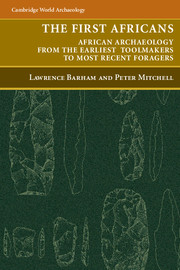Book contents
- Frontmatter
- Contents
- List of Figures and Tables
- Acknowledgements
- THE FIRST AFRICANS
- 1 Introducing the African Record
- 2 Frameworks in Space and Time
- 3 First Tool-Users and -Makers
- 4 Early Pleistocene Technologies and Societies
- 5 Mid-Pleistocene Foragers
- 6 Transitions and Origins
- 7 The Big Dry: The Archaeology of Marine Isotope Stages 4–2
- 8 Transitions: From the Pleistocene into the Holocene
- 9 Hunting, Gathering, Intensifying: The Mid-Holocene Record
- 10 Foragers in a World of Farmers
- 11 The Future of the First Africans' Past
- Notes
- Glossary
- References
- Index
3 - First Tool-Users and -Makers
Published online by Cambridge University Press: 05 June 2012
- Frontmatter
- Contents
- List of Figures and Tables
- Acknowledgements
- THE FIRST AFRICANS
- 1 Introducing the African Record
- 2 Frameworks in Space and Time
- 3 First Tool-Users and -Makers
- 4 Early Pleistocene Technologies and Societies
- 5 Mid-Pleistocene Foragers
- 6 Transitions and Origins
- 7 The Big Dry: The Archaeology of Marine Isotope Stages 4–2
- 8 Transitions: From the Pleistocene into the Holocene
- 9 Hunting, Gathering, Intensifying: The Mid-Holocene Record
- 10 Foragers in a World of Farmers
- 11 The Future of the First Africans' Past
- Notes
- Glossary
- References
- Index
Summary
It is important to distinguish between the using and making of tools in human evolution as these are conceptually different behaviours, and arguably require different cognitive abilities. Tool-users apply unmodified natural objects to do work. Tool-makers deliberately modify materials, and may make tools for use in making other tools. We know more about stone tool technology simply because stone survives better in the archaeological record, but this dichotomy applies equally to organic materials, with both having the potential to provide information on the extent of learned as opposed to innate behaviours. Examples of the learned ability to use tools occur in just a few non-primate species such as the Californian sea otter, bottlenose dolphin, and Egyptian vulture. Tool-making is even rarer among non-primates, with only the New Caledonian crow observed to shape leaves into a variety of tools for extracting insects from crevices (Hunt et al. 2004). The ability of young crows to make leaf tools in captive isolation without input from peers or parents indicates an innate behaviour transmitted genetically rather than socially, though some details of shaping tools may be learned by observation (Kenward et al. 2005). The ability of primates, in particular chimpanzees, to use and make tools is now well documented (Whiten et al. 1999), and involves a degree of social learning surpassed only by humans.
- Type
- Chapter
- Information
- The First AfricansAfrican Archaeology from the Earliest Toolmakers to Most Recent Foragers, pp. 59 - 107Publisher: Cambridge University PressPrint publication year: 2008



